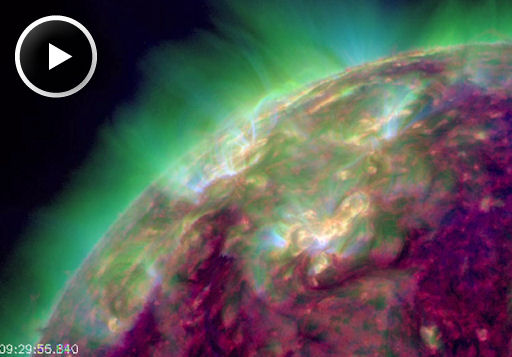RADIATION STORM HITS MARS ROVER: En route to the red Planet, Mars rover Curiosity has experienced the strongest solar radiation storm since 2005. The rover is okay. Researchers say this is a normal part of Curiosity's job as 'stunt double' for human astronauts. [full story] [video]
SUNSET SKY SHOW: When the sun goes down tonight, step outside and look west. Jupiter, Venus and the crescent Moon are forming a broad line in the sky. Daniele Gasparri photographed the arrangement from Bologna, Italy:
From upper left to lower right, the lights are Jupiter, Venus, and the Moon--all three bright enough to beam through thin clouds.
Soon, this line will collapse to form a triangle. The best nights to look are Feb. 25th and 26th when the crescent Moon glides by Venus, then Jupiter for a lovely display of celestial geometry. Get the full story and a video from Science@NASA.
more images: from Wienie van der Oord of Negev desert; from Ali Al-Hajari of Isa Town, Bahrain; from P-M Hedén of Vallentuna, Sweden; from Laurean of Tirgu Mures, Romania; from Piotr Potepa of Torun, Poland; from Juan Miguel González Polo of Cáceres,
Extremadura, Spain; from Ian Griffin of Brill, Oxfordshire, England;
SOLAR TSUNAMI: Tangled magnetic fields on the sun's NW limb erupted today, February 23th, producing a solar tsunami. You can see the shadowy yet powerful wave rippling away from the blast site in this move from the Solar Dynamics Observatory:
The wave is subtle. If you didn't see it the first time, watch the movie again and look for regions on the solar surface that light up as the wave passes by. The nearly transparent ripple of plasma and magnetism was probably ~100,000 km high and, racing outward at a typical speed of 250 km/s, packed as much energy as 2.4 million megatons of TNT (1029 ergs). On the scale of the sun, it doesn't look like much, but you wouldn't want to run into one on Earth.

![]()
Solar wind
speed: 422.2 km/sec
density: 3.5 protons/cm3
explanation | more data
Updated: Today at 1436 UT
![]()
X-ray Solar Flares
6-hr max: B5 1216 UT Feb24
24-hr: B6 0221 UT Feb24
explanation | more data
Updated: Today at: 1400 UT
![]()
![]()
![]()
Daily Sun: 24 Feb 12
![]()
![]()
A new sunspot is emerging at the circled location. Credit: SDO/HMI
![]()
![]()
![]()
Sunspot number: 52
What is the sunspot number?
Updated 22 Feb 2012
Spotless Days
Current Stretch: 0 days
2012 total: 0 days (0%)
2011 total: 2 days (<1%)
2010 total: 51 days (14%)
2009 total: 260 days (71%)
Since 2004: 821 days
Typical Solar Min: 486 days
Updated 22 Feb 2012
The Radio Sun
10.7 cm flux: 104 sfu
explanation | more data
Updated 22 Feb 2012
![]()
![]()
![]()
Current Auroral Oval:
![]()
Switch to: Europe, USA, New Zealand, Antarctica
Credit: NOAA/POES
![]()
![]()
![]()
Planetary K-index
Now: Kp= 1 quiet
24-hr max: Kp= 3 quiet
explanation | more data
![]()
Interplanetary Mag. Field
Btotal: 2.3 nT
Bz: 1.2 nT south
explanation | more data
Updated: Today at 1436 UT
![]()
![]()
![]()
Coronal Holes: 23 Feb 12
![]()
![]()
A solar wind stream flowing from the indicated coronal hole should reach Earth on Feb. 25-26. Credit: SDO/AIA.
![]()
![]()
![]() SPACE WEATHER
SPACE WEATHER
NOAA Forecasts

![]()
![]()
Updated at: 2012 Feb 23 2200 UTC
![]()
![]()
![]()
![]()
Geomagnetic Storms:
Probabilities for significant disturbances in Earth's magnetic field are given for three activity levels: active, minor storm, severe storm
![]()
Updated at: 2012 Feb 23 2200 UTC






